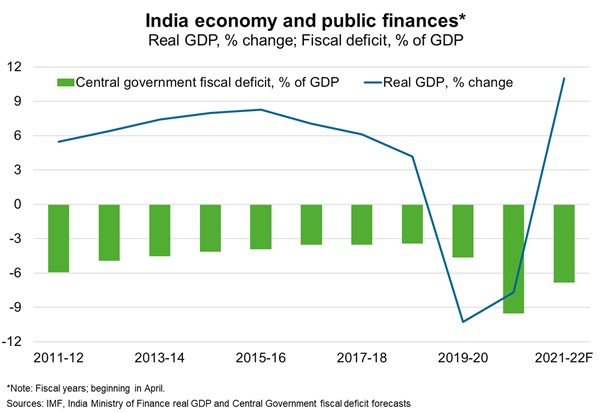India—Fast recovery in 2021 as government ramps up spending
Following a record economic contraction in the wake of the COVID-19 pandemic, India’s recovery is expected to be swift and sharp in 2021. The government has shifted its focus from fiscal consolidation to boosting economic growth—unveiling spending plans worth INR35 trillion (US$480 billion, more than 16% of GDP) in the 2021 budget (fiscal year covering April 2021 to March 2022). The budget plans to sharply increase spending on infrastructure, power distribution and healthcare, supporting cement, steel, power, automotive and pharmaceuticals industries. Rising vaccinations, alongside broadly stable tax rates, should support the recovery in household consumption. However, rising COVID-19 infections are a key near term risk; confirmed daily cases surged above 68,000 on 28 March, down from a peak of almost 100,000 in mid-September, but up from less than 10,000 a month earlier.
The budget projects the fiscal deficit to reach 6.8% of GDP in fiscal 2022, following a large 9.5% deficit in 2020-21. Additional borrowing to finance deficit-spending will push central government debt toward 60% of GDP in 2021-22, from 50% in 2019-20. A sustained increase in GDP growth will be important to consolidate public finances and reduce high fiscal risks. India’s economy exited recession in the fourth quarter of 2020 and this positive economic momentum is expected to continue over the next 12 months (Chart). The OECD expects real GDP to grow 12.6% in 2021 following an estimated 7.4% contraction in 2020.
Assuming the fiscal risks are contained, India’s stronger economic growth outlook offers opportunities for Australian coal, natural gas, copper and gold producers to boost exports. However, international travel restrictions will continue to disrupt tourism and education exports. Total Australian exports to India fell almost 20% to $18.6 billion in 2019-20. However, recent exports in December 2020 and January 2021 were up over 40% compared to a year ago.

